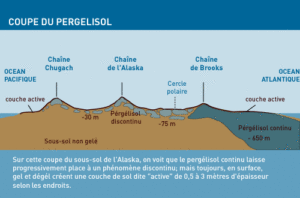
CONTENTS
OCEAN AND MARINE LIFE
- THE ARCTIC OCEAN AND THE OCEAN CURRENTS
- GENESIS OF THE ARCTIC OCEAN
- ARCTIC PLANKTON
- MARINE BIODIVERSITY AND FOOD WEB
- WHALES AND OTHER CETACEANS
- SEALS AND WALRUSES
TERRESTRIAL LIFE
- POLAR FLORA
- POLAR FAUNA
- THE POLAR BEAR
- ARCTIC BIRDS
- SPECIES EVOLUTION AND CLIMATE
HISTORY AND GEOGRAPHY
- GEOGRAPHY OF THE ARCTIC REGIONS
- GEOGRAPHIC NORTH POLE, MAGNETIC NORTH POLE
- WHO OWNS THE ARCTIC?
- THE EXPLORERS OF THE FAR NORTH
- THE INUIT
- OTHER PEOPLES OF THE FAR NORTH
- THE ARCTIC TODAY
THE ARCTIC REGIONS: SITTING ON PERMAFROST
Permafrost is the term given to frozen ground that never completely thaws in summer, sometimes remaining frozen as far as hundreds of metres down. The Arctic permafrost covers millions of square kilometres from Alaska to the northern reaches of Russia and China. In summer, because only the surface thaws and the deeper layers stay frozen, melt-water is not absorbed by the ground and it stagnates, creating vast marshland zones (wetland ecosystems).

A LAND FROZEN HARD
When the ground in the Arctic freezes it contracts and splits in geometric patterns, often polygons. Where water has seeped into rocks, it expands when it freezes and splits the rock. Elsewhere, the rocks are worn by the incessant wind. Sometimes, ice expansion due to underground water freezing lifts up great stretches of ground, forming steep embankments that are quickly colonised by the Arctic vegetation in summer.
LANDSCAPES SHAPED BY THE THAW TOO
In summer, the ground thaws but only on the surface. The water mingles with the surface layer forming mud that slides down the slightest slope. The thaw causes major erosion along the banks of rivers, lakes and even on the shores of the Arctic Ocean.


BEARING WITNESS TO PAST ICE AGES
Ice ages always leave traces on the landscape, and these physical traces can tell us much about the climate in the past. For example, glaciers deposit moraines, leave tell-tale scratches in the rock and carve U-shapes into lakes and valleys. Along coasts, geologists sometimes find fossilised terraces and beaches well above the present sea level, showing how the sea level has changed as ice ages came and went.Les périodes glaciaires laissent des traces dans les paysages. On les utilise pour connaître l’histoire des climats. Les glaciers déposent des moraines et strient certaines roches ; ils creusent aussi lacs et vallées en U. Sur les côtes, on retrouve parfois, des terrasses ou plages fossiles, perchées au-dessus du niveau actuel de la mer. Elles témoignent des fluctuations du niveau marin au fil des glaciations.


